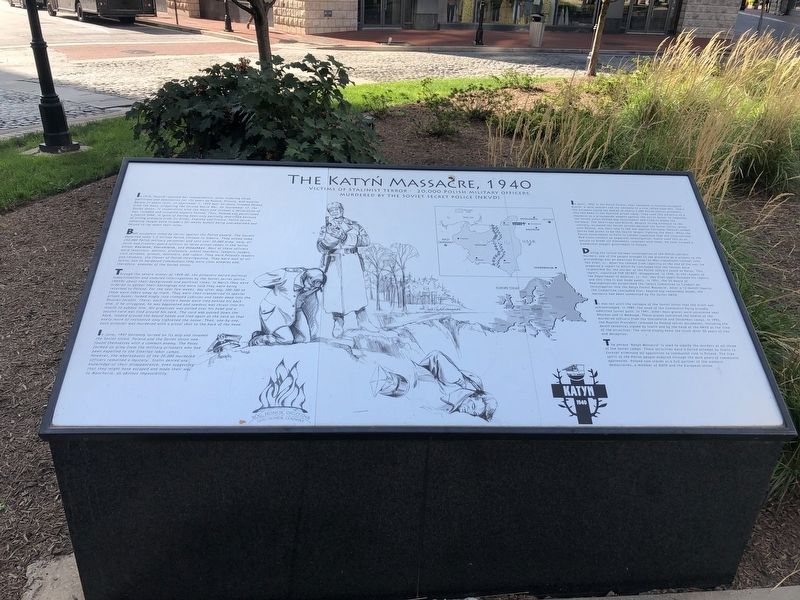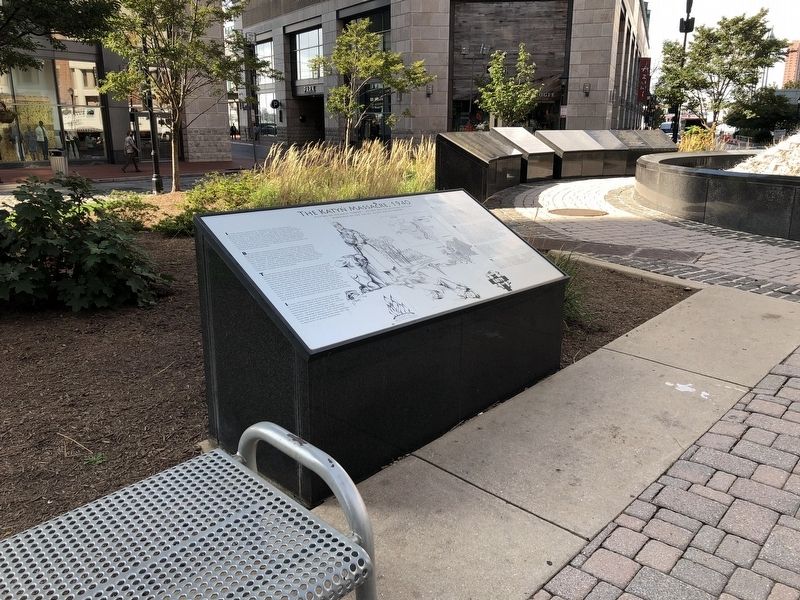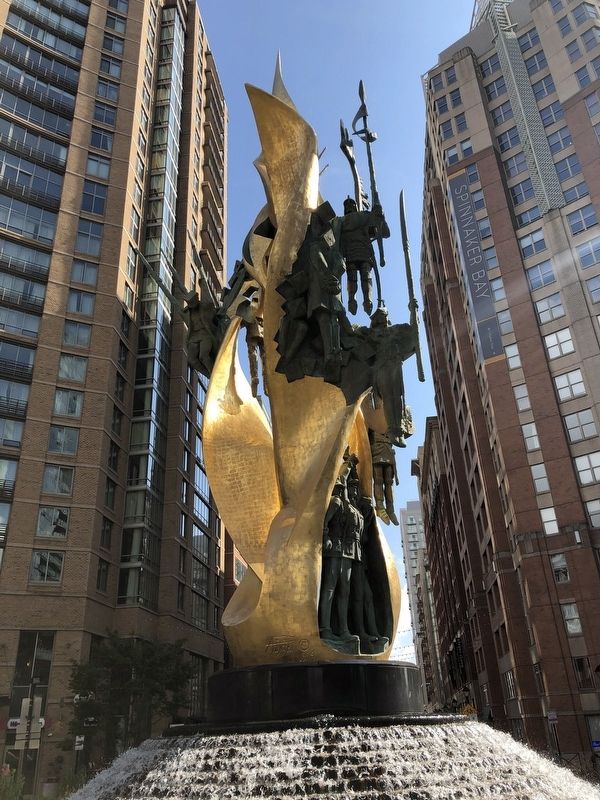Inner Harbor in Baltimore, Maryland — The American Northeast (Mid-Atlantic)
The Katyń Massacre, 1940
Victims of Stalinist Terror
— 20,000 Polish military officers murdered by the Soviet Secret Police (NKVD) —
In 1918, Poland regained her independence, after enduring three partitions and domination for 123 years by Russia, Prussia, and Austria. Barely 21 years later, on September 1, 1939 Nazi Germany invaded Poland from the west, triggering the Second World War. On September 17, the Soviet Union, in cooperation with the Nazis and without a declaration of war, invaded and occupied eastern Poland. Thus, Poland was partitioned a fourth time. In spite of having been only partially mobilized because of strong pressure from its Allies, England and France, Polish forces valiantly fought both invaders for weeks before being overwhelmed and forced to lay down their arms.
Both occupiers ruled by terror against the Polish people. The soviets deported some 1.5 million citizens to Siberia. They seized some 250,000 Polish military personnel and sent over 20,000 army, navy air force and frontier-guard officers to three prison camps in the Soviet Union: Kozielsk, Starobielsk, and Ostashkov. Most of these officers were reservists: doctors, professors, school teachers, lawyers, judges, civil servants, priests, ministers, and rabbis. They were Poland's leaders and thinkers, the flower of Polish intelligentsia. They were men of all faiths, but to hardened Communists they were class enemies, and, therefore, enemies of the Soviet Union.
Through the severe winter of 1939-40, the prisoners defied political indoctrination and endured interrogations by the Soviet secret police (NKVD) about their backgrounds and political views. In March they were ordered to gather their belongings and were told they were being returned to Poland. For the next few weeks, day after day, 200-300 of them were taken away by train. They were then transferred to special prison buses, locked singly into cramped cubicles and taken deep into the Russian forests. There, each victim's hands were tied behind his back and, if he struggled, he was bayoneted and sawdust was thrust into his mouth to subdue him. His greatcoat was pulled over his head and a second cord was tied around his neck. The cord was passed down the back, looped around the bound hands and tied again at the neck so that every move of resistance only tightened the noose. Then, one-by-one, each prisoner was murdered with a pistol shot to the back of the head.
In June, 1941 Germany turned on its ally and invaded the Soviet Union. Poland and the Soviet Union now found themselves with a common enemy. The Poles formed an army from the military prisoners who had been expelled to the Siberian labor camps. However, the whereabouts of the 20,000 murdered officers remained a mystery. Stalin denied any knowledge of their disappearance, even suggesting that they might have escaped and made
In April, 1943 in the Katyń Forest, near Smolensk in German-occupied Russia, a local peasant led the Germans to a site called Goat Hill. There the Germans found the bodies of nearly 5,000 Polish officer-prisoners who had been in the Kozielsk prison camp. They used this evidence of a massacre as a propaganda weapon against the Soviet Union. In response, the Soviet Union denied any involvement and tried to blame the Germans. The Americans and British, despite strong evidence to the contrary, accepted the Soviet version because the Soviet Union, along with Poland, was their ally in the war against Germany. Poland's armed forces had grown to be the fourth largest fighting the Nazis. When the Polish Government-in-Exile in London requested that the International Red Cross conduct an impartial investigation, Stalin used this as an excuse to break off diplomatic relations with them. He later formed a Communist puppet government in Poland.
During the initial German investigation of the Polish officers' murders, one of the people brought to the gravesite as a witness to the proceedings was an American Prisoner-of-War, Lieutenant Colonel John Van Vliet, Jr. After his release from captivity at the end of the war, he prepared a report in which he concluded that the Soviets were responsible for the murder of the Polish
It was not until the collapse of the Soviet Union that the truth was acknowledged. In 1989, the head of the Communist Party broadly admitted Soviet guilt. In 1991, other mass graves were uncovered near Kharkov and in Mednoye. These graves contained the bodies of the murdered officers from the Starobielsk and Ostashkov camps. In 1992, the Russian President released to Poland secret documents, including the death sentences signed by Stalin and the head of the NKVD at the time of the atrocities. The world finally knew the truth after 50 years of lies and deception.
The phrase "Katyń Massacre" is used to signify the murders at all three of the Soviet Camps. These atrocities were a failed attempt by Stalin to forever eliminated all opposition to communist rule in Poland. The free spirit of the Polish people endured through the dark years of communist oppression. Poland now stands as a full partner of the western democracies, a member of NATO and the European Union.
Topics. This historical marker is listed in this topic list: War, World II. A significant historical date for this entry is September 1, 1931.
Location. 39° 16.991′ N, 76° 36.088′ W. Marker is in Baltimore, Maryland. It is in the Inner Harbor. Marker is at the intersection of President Street and Aliceanna Street, in the median on President Street. Touch for map. Marker is at or near this postal address: 790 Aliceanna St, Baltimore MD 21202, United States of America. Touch for directions.
Other nearby markers. At least 8 other markers are within walking distance of this marker. The National Katyń Memorial (within shouting distance of this marker); Katyń Remembered (within shouting distance of this marker); President Street Station (about 400 feet away, measured in a direct line); Baltimore Riot Trail (about 400 feet away); The Inner Harbor Water Wheel (about 600 feet away); Discover Little Italy: A Taste of the Past (about 700 feet away); Baltimore Public Works Museum (about 800 feet away); Rouse-Flick Learning Tower (approx. 0.2 miles away). Touch for a list and map of all markers in Baltimore.
Credits. This page was last revised on October 9, 2021. It was originally submitted on October 9, 2021, by Devry Becker Jones of Washington, District of Columbia. This page has been viewed 185 times since then and 26 times this year. Photos: 1, 2, 3. submitted on October 9, 2021, by Devry Becker Jones of Washington, District of Columbia.


